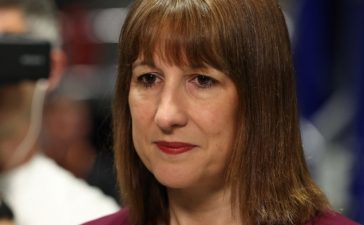UK private sector returns to growth in February
Newsflash: The UK private sector returned to growth in February, ending a six month slump, thanks to an increase in demand and falling inflation.
Data firm S&P Global reports that activity at UK firms is rising this month – indicating that the chances of a near-term recession “have fallen considerably”.
It’s a further welcome piece of good economic news, after Britain posted a surprise surplus this morning.
S&P Global’s flash UK PMI Composite Output Index, which tracks activity in the private sector, has jumped to 53.0 this month up from January’s 48.5. This puts it back into growth territory (over 5o points) for the first time since last July.
Activity at service sector companies hit an eight-month high (with a PMI of 53.3, up from 48.7), while manufacturing output hit a nine-month high (the index rose to 51.6 from January’s 47.0).
Companies surveyed reported rising customer demand and improving business confidence in February, due to lower economic uncertainty, fewer supply shortages and falling inflation.
The PMI indicates the economy showed “encouraging resilience” in the face of rising interest rates, the ongoing cost of living crisis, labour shortages and strikes, says Chris Williamson, chief business economist at S&P Global Market Intelligence.
Williamson adds:
“While many companies continue to report tough operating conditions, especially in the manufacturing sector, the broader business mood has been buoyed by signs of inflation peaking, supply chains improving and recession risks easing.
The stress created by last autumn’s mini budget is also continuing to work its way out of the financial system.
“However, while the data suggest that near-term recession odds have fallen considerably, elevated inflation pressures clearly remain a concern, especially in the service sector.
As such, the resilience of the economy and the stickiness of the survey’s inflation gauges add to the likelihood of the Bank of England tightening policy further, and potentially more aggressively, which may dampen future growth expectations and suggests that the possibility of recession later in the year should not be ruled out.”
The UK narrowly avoided falling into recession at the end of last year, when growth stalled in the final quarter of 2022.
Key events
Filters BETA
Pound jumps as UK companies return to growth
Sterling is rallying in the foreign exchange markets, as traders react to news that UK companies are growing this month for the first time since last summer.
The pound has jumped by over half a cent to hit $1.211, the highest since last Wednesday.
The City will be calculating that stronger economic growth increases the chances of further Bank of England interest rate rises to cool inflation.
This morning’s UK PMI readings “dramatically exceed expectations”, says Daniel Mahoney, UK Economist at Handelsbanken:
The UK Composite Output Index registered at 53, far higher than market predictions of 49 and a 4.5pp increase from January’s print. This is the first time the index has come in above 50 (which indicates private sector expansion) since July 2022.
The UK services PMI is also comfortably in expansionary territory at 53.3, up from 48.7 in January, although the flash manufacturing PMI came in at 49.2, indicating marginal contraction.
Such figures may indicate that forecasters are too downbeat about the UK economy, Mahoney adds:
We will, of course, have to await further data releases to make firm conclusions, but there is no doubt that these much better than anticipated PMI readings could signal that forecasters are currently being too downbeat on short-term growth prospects for the UK economy.
And while it is welcome that the UK economy may be proving more resilient than expected, there is evidence in this release that inflation from the services sector could be especially stubborn, which may indicate that the Bank of England has to tighten monetary policy further.
Samuel Tombs, chief UK economist at Pantheon Macroeconomics, cautions about concluding that the UK will avoid a recession:
The jump in the composite PMI well above 50 in February is encouraging, but I wouldn’t conclude a recession has been avoided just yet. Note it excludes the retail sector (hit by ↓real incomes), construction (hit by ↑borrowing costs) and the strike-afflicted public sector pic.twitter.com/1KybcpWoa7
— Samuel Tombs (@samueltombs) February 21, 2023
“The sun broke through in February after six months of gloom”, says Dr John Glen, CIPS chief economist, as private sector firms enjoyed “a swift and significant jump in output”.
Glen points out that companies didn’t pass on the easing in their costs pressures (as flagged a moment ago):
Supplier delivery times improved at the fastest rate since June 2009 for manufacturers as the marketplace showed signs of some recovery. A rise in new orders and the slowest rate of inflation since April 2021 was reported for businesses overall.
“New work rose at the quickest pace since May 2022 for services businesses which saw more confidence amongst customers than manufacturing and also stronger levels of staff hiring to build operational capacity. Manufacturers saw the wheels of industry grind a little slowly and continued to report job shedding and cautious purchasing activity due to stocks built up last year.
“The easing of input prices didn’t translate into improved costs for customers as these continued to rise and play catch-up. Those providing services cited rising salary costs as the reason for higher prices charged as skills shortages remained widespread. Manufacturers had more leeway to offer their customers better prices for produced orders as raw material costs softened again in February.”
This chart

Companies keep raising prices at rapid rate
Today’s survey of UK purchasing managers also shows that companies continued to raise their prices sharply, despite an easing in their own costs.
Input cost inflation eased for the third month running in February, with manufacturers recording a particularly marked slowdown in price pressures, S&P Global says, adding:
The most commonly cited sources of cost inflation were higher wages, greater energy bills, and exchange rate depreciation against the US dollar. Meanwhile, lower purchase prices mostly reflected reduced fuel costs and falling shipping rates
But, February has brought another “steep increase” in average prices charged by private sector companies, with this rate of inflation only slightly lower than at the start of the year.
The PMI report says:
Lower prices charged inflation was led by the manufacturing sector. The latest rise in factory gate prices was the weakest since January 2021 and much softer than seen in the service economy.
Many service providers suggested that rising staff salaries had led to a sustained increase in their prices charged.
That may concern the Bank of England, which has warned that it could keep raising interest rates if price and wages increases remain high.
Encouragingly, UK firms saw an increase in new business this month, for the first time since last summer.
Total volumes of new work received by UK private sector businesses rose at the strongest pace since May 2022, S&P Global’s nw PMI report shows.
But while there was a “solid upturn” in new orders across the service economy, it fell slightly in manufacturing.
Service providers benefitted from a third consecutive monthly rise in new export sales, while goods producers recorded another decline, the survey of purchasing managers shows.
UK private sector returns to growth in February
Newsflash: The UK private sector returned to growth in February, ending a six month slump, thanks to an increase in demand and falling inflation.
Data firm S&P Global reports that activity at UK firms is rising this month – indicating that the chances of a near-term recession “have fallen considerably”.
It’s a further welcome piece of good economic news, after Britain posted a surprise surplus this morning.
S&P Global’s flash UK PMI Composite Output Index, which tracks activity in the private sector, has jumped to 53.0 this month up from January’s 48.5. This puts it back into growth territory (over 5o points) for the first time since last July.
Activity at service sector companies hit an eight-month high (with a PMI of 53.3, up from 48.7), while manufacturing output hit a nine-month high (the index rose to 51.6 from January’s 47.0).
Companies surveyed reported rising customer demand and improving business confidence in February, due to lower economic uncertainty, fewer supply shortages and falling inflation.
The PMI indicates the economy showed “encouraging resilience” in the face of rising interest rates, the ongoing cost of living crisis, labour shortages and strikes, says Chris Williamson, chief business economist at S&P Global Market Intelligence.
Williamson adds:
“While many companies continue to report tough operating conditions, especially in the manufacturing sector, the broader business mood has been buoyed by signs of inflation peaking, supply chains improving and recession risks easing.
The stress created by last autumn’s mini budget is also continuing to work its way out of the financial system.
“However, while the data suggest that near-term recession odds have fallen considerably, elevated inflation pressures clearly remain a concern, especially in the service sector.
As such, the resilience of the economy and the stickiness of the survey’s inflation gauges add to the likelihood of the Bank of England tightening policy further, and potentially more aggressively, which may dampen future growth expectations and suggests that the possibility of recession later in the year should not be ruled out.”
The UK narrowly avoided falling into recession at the end of last year, when growth stalled in the final quarter of 2022.
Full story: UK posts surprise budget surplus for January after bumper income tax haul

Julia Kollewe
The UK government ran a surprise £5.4bn surplus in January, after bumper self-assessment income tax receipts, leaving some rooms for giveaways in the chancellor’s budget next month according to some economists.
The surplus was £5bn higher than the government’s fiscal watchdog, the Office for Budget Responsibility, had expected, although it was £7.1bn smaller than in January 2022, according to figures from the Office for National Statistics. Analysts polled by Reuters were taken by surprise, having instead predicted that the government would have to borrow £7.8bn in January.
Government coffers were boosted by £21.9bn of self-assessed income tax receipts, the highest January figure since monthly records began in April 1999.
They were partly offset by substantial spending on energy support schemes for households and businesses to cushion the blow of spiralling energy prices, and large one-off payments relating to historic customs duties owed to the EU, the ONS said.
Investec: Public finances could allow some pre-election tax cuts
The UK’s surprise surplus of £5.4bn last month may suggest a slightly “rosier picture” than expected for the public finances, says Philip Shaw of Investec.
Shaw says the “buoyancy” of tax receipts last month was striking, with total tax revenues up 13.2%
Corporation tax was 27.9% higher, self-assessed income tax 33.3% up and PAYE income tax 10.6% above January 2022 levels, helped by high inflation and a strong labour market.
Shaw suggests that Jeremy Hunt is unlikely to cut taxes next month, but there could be flexibility for some pre-election giveaways at a later date, before we head to the polls in (probably) 2024.
These figures were the last data on the public finances ahead of the Budget on 15 March. Chancellor Hunt has made it clear that there will be no room for significant tax reductions. We would tend to take him at his word.
Today’s figures though show that over the first 10 months of 2022/23, cumulative borrowing has reached £108.7bn, £29.9bn less than the OBR had pencilled in for the same period. Furthermore official numbers so far on the cost of the energy schemes are early estimates. It seems feasible that a relatively warm winter has resulted in households and businesses using less energy, implying lower government payments to energy suppliers. Moreover the fall in wholesale gas prices has implications for the second half of the year.
Our Utilities team recently pointed out that at current levels, movements in wholesale markets over the past few weeks imply an energy price cap of £2165 in July and £2190 in October, well below the government’s energy price guarantee level of £3000, which would remove the need for any government funding of the EPG between this July and April next year.
It is still relatively early days but it is possible to envisage events playing out where borrowing falls significantly below expectations, facilitating at least some tax cuts ahead of a 2024 election.
Eurozone business growth hits nine-month high in February
A pick-up in service sector growth has driven eurozone business activity growth to a nine-month high, data just released shows, bolstering hopes that Europe can avoid a recession this year.
The S&P Global ‘flash’ Eurozone PMI has risen for the fourth month running, rising to 52.3 in February from January’s 50.3 (any reading over 50 shows growth).
S&P Global, the data firm, reports that eurozone service sector firms achieved an improved performance, while manufacturing output returned to growth.
Rising demand, healing supply chains, order book backlog reduction and improved confidence underpinned the upturn. The data suggests that the economy expanding in the first quarter so far, with employment also continuing to rise.
Selling price inflation slowed to a 16-month low, although remained “stubbornly high”, especially in the service sector, in part linked to the impact of higher wage costs.
February Flash PMIs #breaking
Services improves while manufacturing shrinks
France’s manuf. flash PMI slipped to 47.9 vs. 50.5 in Jan.
Services hits 52.8 vs. 49.4 in Jan, beating expectations
Germany’s manuf. fell to 46.5 vs 47.3 in Jan
Services hit 51.3 vs. 50.7 in Jan
— Victoria Scholar (@VictoriaS_ii) February 21, 2023
Chris Williamson, Chief Business Economist at S&P Global Market Intelligence says February’s PMI is broadly consistent with GDP rising at a quarterly rate of just under 0.3%.
“Growth has been buoyed by rising confidence as recession fears fade and inflation shows signs of peaking, though manufacturing has also benefitted from a major improvement in supplier performance.
The pandemic-related delivery delays that dogged factories over the past two years have given way to faster delivery times, in turn meaning pricing power is shifting from suppliers to factory purchasing managers, bringing industrial price inflation down. “However, although inflationary pressures have continued to moderate in February, the survey hints at persistent elevated price trends in the service sector, linked in part to higher wage growth, which will concern ECB policymakers.
The combination of accelerating growth and stubbornly elevated price pressures will naturally encourage a bias towards further policy tightening in the months ahead.”
Stamp duty has pulled in an extra £1.7bn into the government’s coffers so far this year, new figures from HM Revenue and Customs show.
Since April, overall stamp duty receipts have hit £16.8bn, up from £15.1bn a year earlier.
But, growth has slowed, as the housing market was hit by soaring mortgage costs.

In total, HMRC receipts for April 2022 to January 2023 jumped by £65.1bn to £660bn, also lifted by income tax, capital gains tax & national insurance contributions (NICs), and business taxes.
HMRC says:
in percentage terms, receipts were higher from business taxes (25%), Inheritance Tax (17%), environmental taxes (15%), Income Tax, Capital Gains Tax & NICs (14%) and stamp taxes (11%)
‘Fiscal drag’ – the freezing of income tax receipts levels – also boosted the tax take.
Helen Morrissey, head of retirement analysis at Hargreaves Lansdown, explains:
“After flying high for so long there are clear signs the property market is starting to slow, and this can be seen in stamp duty receipts.
They are still up on the same period last year, but the direction is turning as mini-Budget mayhem and the cost of living turned people off the idea of moving home. House price growth is stuttering to a halt and homes are taking longer to sell so we will likely see stamp duty receipts come off further in the coming months though mortgage rates have started to come down which could tempt some people into taking the plunge in the coming months.
Ongoing tax threshold freezes continued to play their part with income tax and inheritance tax receipts continuing to rise as more and more people get pulled into paying them.
Resolution Foundation: Jeremy Hunt benefits from healthier borrowing levels
With UK government borrowing £30bn lower than expected so far this year, Jeremy Hunt has been handed “a fresh tonic” as he prepares to deliver his Spring Budget in three weeks’ time.
That’s the verdict from the Resolution Foundation on this morning’s public finances.
They point to the record self-assessment tax receipts in January (up by a third to £21.9bn), which was partly offset by spending on energy support measures and high debt interest.
Falling wholesale gas prices should deliver a further fiscal boost next year, with the cost of the Energy Price Guarantee set to fall from £11.8bn to just £1.5bn, Resolution Foundation expect, when the price cap is raised in April.
Cara Pacitti, senior economist at the Resolution Foundation, says:
“The Chancellor is approaching his upcoming Budget with significantly healthier borrowing levels than was forecast last Autumn.
“However, with borrowing still much higher than last year, and with interest rates likely to remain elevated for some time to come, Jeremy Hunt can’t afford to be relaxed about the state of the public finances.
“The extra fiscal headroom should allow him take on some key issues however – namely corporate reform, boosting workforce participation and preventing a spike in energy bills this spring.”









